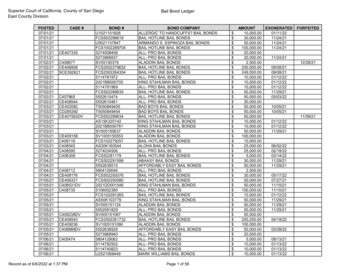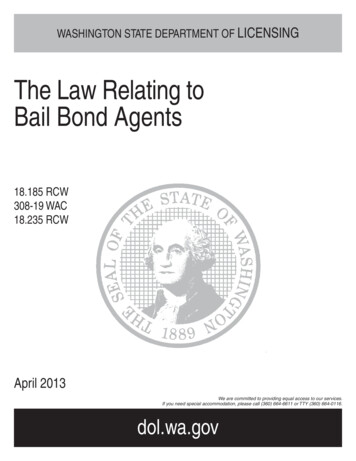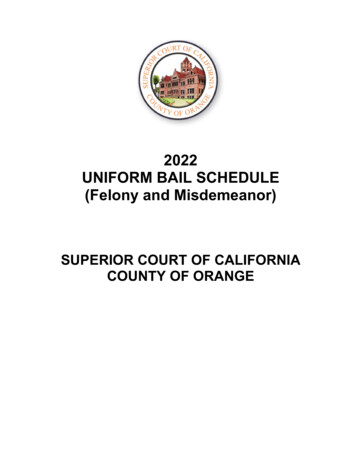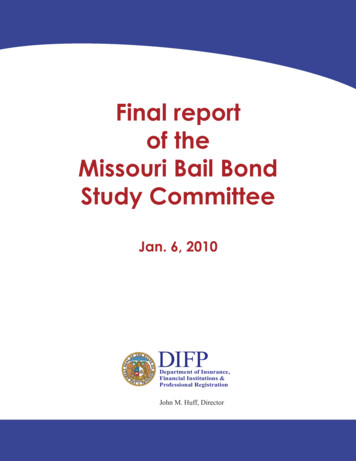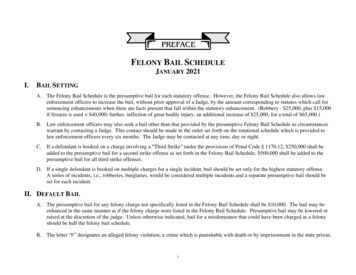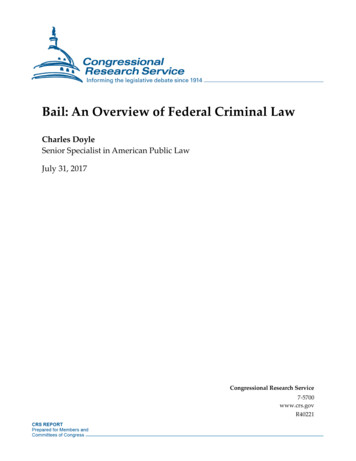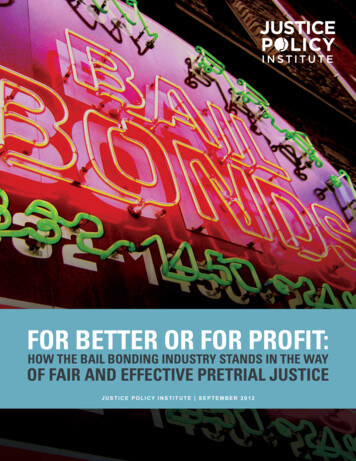
Transcription
For Better or For Profit:How the Bail Bonding Industry Stands in the Wayof Fair and Effective Pretrial JusticeJUSTICE POLICY INSTITUTE SEPTEMBER 2012
2justice policy instituteCONTENTS3PART 1: INTRODUCTION5PART 2: HISTORY AND CONTEXT7Special Feature: Lamont Redman9The Language of Bail Bonding: A Glossary of Key Terms10PART 3: HOW DOES BAIL BONDING WORK?12 PART 4: For-profit bail takes advantage oF low incomecommunitiesThe Justice Policy Instituteis a national organizationfocused on reducing the useof incarceration and the justicesystem and promoting policiesthat improve the well-being ofall people and communities.14Where Does the Money Go?16Special Feature: Jerome LaCorte17 PART 5: FOR-PROFIT BAIL BONDSMEN ARE NOT CRIMINALJUSTICE PROFESSIONALS.17 Bail bondsmen don’t address public safety.18Special Feature: Dave Weissert19 Unlike bondsmen, Pretrial Services agencies measure risk,facilitate services.21 Bail Bonding is not “cheaper” than pretrial services.24Special Feature: Greg Carpenter25 For-profit bail bonding affects judicial decisions around release.25 For-profit bail bonding affects judicial decisions around release.26PART 6: POLITICAL INFLUENCE KEEPS BAIL BONDSMEN IN BUSINESS26 The for-profit bail industry uses lobbyists to pass legislation favorable totheir bottom line.30 For-profit bail bonding is backed by deep pockets.32The ABC-ALEC connection35Recent Legislation Shows the Industry is Fighting Hard—Against Reform.36Special Feature: John Clark40 PART 7: BY ITS VERY NATURE, FOR-PROFIT BAIL IS RIPE FOR CORRUPTIONAND ABUSE40 Corruption43 PART 8: ALTERNATIVES TO FOR-PROFIT BAIL BONDING EXIST ANDARE EFFECTIVE.43Multnomah County, OR44 Kentucky45The Federal System1012 14th Street, NW, Suite 400Washington, DC 20005TEL (202) 558-7974FAX (202) 558-797845Recommitting to the promise of pretrial services agenciesWWW.JUSTICEPOLICY.ORG46PART 9: RECOMMENDATIONS46End for-profit bail bonding.46Promote and further institutionalize pretrial services.47Require greater transparency within the industry.48 ENDNOTES
For Better or For Profit:How the Bail Bonding Industry Stands in the Wayof Fair and Effective Pretrial JusticeJUSTICE POLICY INSTITUTE SEPTEMBER 2012
2justice policy institute60%of people held inU.S. jails are awaitingtheir day in court.
F or B etter or For Profitpart 1IntroductionThe for-profit bail bonding industry exerts control and influence over pretrialdecision-making in jurisdictions throughout the country. Despite a checkeredpast, for-profit bonding is now a multi-billion dollar industry backed by giant insurance companies and trade associations with the money and political powerneeded to maintain their place in the criminal justice system.The industry continues to prosper and growjurisdictions, as many as 71 percent of people in jaildespite decades of research and reform effortshave a pretrial status.that have changed the pretrial landscape to onethat no longer requires the services of the professional bondsman.As courts increasingly recognize the ineffectiveness of for-profit bail bonding, the number ofpeople released through a bail bond, and simulta-In contrast to other pretrial mechanisms, for-profitneously supervised and monitored by PTS agen-bail bonding is unable to effectively manage peoplecies has grown dramatically, resulting in a greaterwho are released pretrial. Other methods of release,taxpayer burden. This is solely due to deficits insuch as the use of pretrial services (PTS) agencies,the for-profit bail bonding service. Likewise, be-gauge pretrial risk based on several factors includ-cause of the lack of industry regulation, courts of-ing prior criminal record, substance abuse historyten choose to play it safe by raising bail amounts.and severity of the current charge, to name but aThis increases pretrial jail populations for thosefew. For-profit bail bondsmen assess risk based thewho can’t afford release and increases the financialability of the person—or their family—to pay theburden of those who can.bond premium, and the risk they will have to paythe full bond amount if they fail to appear in court.With the personal liberty of accused people heldby a profit-driven private industry, for-profitThe industry touts its services as coming at no cost,bail bonding is systemically prone to corruption,but the system is very costly to the taxpayer andcriminal collusion, and the use of coercion againstto the individuals and families who enter into thebonded people. This phenomenon is not new andbail bond agreement. Many of those who cannothas plagued the industry for decades, resulting in aor do not purchase a bail bond will remain in jailban on for-profit bonding in four states.until their trial date, sometimes as long as a year.This has contributed to dangerously high jail populations, with a national average of 60 percent ofpeople in jail awaiting their day in court. In someThe practice has been criticized widely for decadesby such groups as the American Bar Association,International Association of Chiefs of Police, the3
4justice policy instituteAmerican Civil Liberties Union and numerousalternatives that the U.S. will be able to eliminateother criminal and social justice stakeholders. For-the use of the for-profit bail bonding industry,profit bail bonding continues, however, largely be-and ultimately money bail itself, while improvingcause of the political influence the industry is ableoutcomes for people and communities and safelyto leverage through lobbying, campaign donationsreduce jail populations, resulting in less costs andand association with powerful anti-reform organi-more safety for all of us.zations. In numerous instances the for-profit bailbond industry has fought pretrial reform throughthe use of industry lobbyists, significant donationsto industry-friendly policymakers, backroom influence and legislation with the help of their conservative corporate-financed partner: the AmericanLegislative Exchange Council (ALEC).There are proven alternatives to the for-profit system that rely on statistically validated assessmentsof risk and a continuum of pretrial release optionsinstead of money. It is through the use of theseThe only risk that for-profit bailbondsmen consider is financial:can the client pay the bondpremium and the full bail amount?And what is the likelihood they’llhave to pay a forfeiture for afailure to appear?
F or B etter or For Profitpart 2HISTORY AND CONTEXTThe use of money bail the larger practice of bail within which for profit bailbonding exists can be traced back 1,000 years to medieval England. Its intended purpose was basically the same as it is today: to ensure a person whohas been arrested and released pretrial shows up for their future trial date.By using money as guarantee for trial appearanceFor-profit bail bonding—the practice of hiring aat a time when most punishments were monetary,third party to pay or provide a surety guarantee forthe system had a measure of internal consistency,one’s bail—is commonly believed to have begunmaking it “perhaps the last entirely rational appli-in the U.S. around 1898 by underworld bosses thecation of bail.”McDonough brothers, who were active in gamblingBail was broughtand prostitution rings in rough-and-tumble, turnto America withof the century San Francisco. The McDonoughsEnglish settlers,bailed out people in these illicit industries so theywhere the prac-could return to work as quickly as possible.3 Eventice remainedin what was considered to be an “open town”mostly the samewith a high tolerance for extra-legal activities, theuntil the lateMcDonough’s bail business was seen to be a “foun-19 century andtainhead of corruption.”4 In 1912, the San Franciscowas even codi-police chief said of bondsmen, “they are simplyfied into the 8shysters, the offal of the earth, and they should be1ththAmendment ofdriven from business, from the police courts.”the Constitution.2Money bail remains an integralpart of the crimi-The world’s first for-profitbail bonds company, run bySan Francisco crime bosses,the McDonough Brothers.Photo: San Francisco History Center, San FranciscoPublic Librarynal justice systemin most parts ofthe U.S. today asa condition forpretrial release.One hundred years later the bail bonding industry, now a billion-dollar business, continues toenjoy considerable political influence. But thepadded envelopes of the early twentieth centuryin large part have been replaced by campaign donations and lobbyists who promote the industry’sright to exist, reduce competition from alternatives to bail bonding like pretrial supervision, andensure that profit margins remain high through5
6justice policy institutethe reduction of risk in the form of forfeitureson personal recognizance for people charged with(that is, payment of the full bail amount for some-non-capital offenses, placed restrictions on the useone who does not appear for trial).of money bail and promoted the use of pre-trialTwo primary factors contributed to the rise ofthe professional bail bondsmen in the early partof the 20th century. First, the growing AmericanWest meant many lacked strong social networksof friends, family and neighbors upon whom tocall for help raising bail; people who couldn’t af-services within the Federal court system. Followingthat, the American Bar Association (ABA) releasedits updated Standards, stating that the for-profitbond agent “is neither appropriate nor necessaryand the recommendation that they be abolished iswithout qualification.”7ford to remain in jail were willing to sacrifice theDespite these attempts at reform, by the 1970snon-refundable fee in order to remain free pendingbail bond-related corruption and influence withintrial. Second, bail amounts began to rise, makingthe criminal justice system reached such a levelit harder for the average person to pay the full bailthat four states Illinois, Wisconsin, Kentuckyamount. The blossoming for-profit bail industryand Oregon banned the practice, opting insteadused that opportunity to establish itself as an ev-for non-financial release mechanisms or allowingeryday part of the criminal justice system. In fact,accused people to place a refundable deposit withcommercial bail proponents use the language ofthe court (known as deposit bail). Commercial bailtradition to portray the practice as integral to theis still prohibited in those states and has been lim-operation of the American criminal justice systemited or made scarce in several other jurisdictionsand its absence as unimaginable.since that time.However, as early as the 1920’s critics raised wor-Following several high profile offenses committedrying issues. Arthur L. Beeley, in his 1927 study,by people who had been released on bail, CongressThe Bail System in Chicago, noted that poor peoplepassed the Bail Reform Act of 1984. The intent ofremained in pretrial detention solely because ofthe act was to add the consideration of dangerous-their inability to pay even small bail amounts; heness to the bail decision, in addition to likelihoodbelieved the role of bail bondsmen had becomeof future court appearance. The result of the Act, intoo prominent in the administration of justice, andFederal Courts as well as the local courts that ad-corruption and a failure to pay bond forfeituresopted the tenets of the Act, was an increase in bailplagued the industry. Amazingly, these issues areamounts, which in turn increased the number ofstill at the heart of what is wrong with the for-people who remained in jail prior to trial,8 as well asprofit bail system in America today.6the bottom line for bail bondsmen, who generally5Out of concern over the disparate treatment of thosewho could or could not afford bail, the 1961 Man-collect and keep ten percent of the bail amount. Asthe Reform Act coincided with a surge in the Warhattan Bail Project sought to demonstrate that people who had been arrested could be released undernon-financial conditions with low failure-to-appear(FTA) rates. The project, which became the flagshipfor the Vera Institute of Justice, was successful andopened the door for the Federal Bail Reform Act of1966. This Act emphasized a presumption of release“Their role is neither appropriatenor necessary and the recommendation that they be abolished iswithout qualification.”–american bar association
F or B etter or For Profit 7Lamont RedmanThe bail review process exists to determine flight risk and danger to the community at large.There are some people out there who absolutely don’t deserve bail. If you have been locked up numerous times for the same thing, you don’t deserve bail. But if you have somebody who is a first-timeoffender and has no record and gets the book thrown at them, it shouldn’t be like that.I’ve seen people basically having to putup houses or take outloans against theirproperty to come upwith bail amounts toget out of prison.Sometimes there’s too much judgment involved instead of going bywhat is stated on paper. It’s always dependent on how that personmay feel that day. To me, there is no continuity in it. Depending onthe mood the commissioner may be in, you may get a higher bail orlower bail. Or, this commissioner might go by the book; that commissioner might not go by the book. This judge might do it this way;another judge might not. I think that the way the law should be setup is that everything should be black and white. There shouldn’t bepaint involved in the bail process.I’ve seen people basically having to put up houses or take out loansagainst their property to come up with bail amounts to get out of prison. And you are talking about a lotof people who just don’t have that kind of money. A lot of the bail bondsmen in the city, they work witha lot of people. They even go down to one percent, as far as putting down to get people out. But likeI said, they’ve got regular families putting houses down. They are not the ones getting locked up, butthey’ve got to put their houses up, and if this person runs, you can lose your house. Or take out a loan,a payday loan from these predatory loan companies that try to get the money to bail somebody out ofprison. And that’s where it starts affecting everybody.Like I said, this person is not a danger or flight risk, so why should they have to go through all this burden? Don’t get me wrong; if somebody commits a crime, that’s their fault. But, should there even be abail in that case, or should it just be release? Major cases, I understand that—like murders, burglary,theft anything like that. But a lot of these guys are locked up for drug charges, and not for selling, butfor using. What’s the purpose of continuing to give them bails? It drains the system, it overcrowds thejails, and you put an unnecessary troublesome burden on their families. Put these guys in treatment.So that’s my problem with it all. That’s why, depending upon the crime, sometimes bail doesn’t seemneeded. It’s cumbersome, and it puts an unnecessary burden on family members. Nobody wants tosee their child or mother or father behind bars, but sometimes, if you got to stay there, it does a lot toaffect a family—especially in cases where it’d be more useful and helpful to the community at largeto put these guys in treatment, not keep putting them behind bars. They get no treatment behind barsmost of the time. So, how’s this helping?It’s a big racket. Like I said, the whole bail system has its pros and cons, but I believe that for lesser pettycharges, there shouldn’t even be a bail process for that. Lock them up, give them the charge, let them go.““Case Manager, Jericho Reentry Program, Baltimore, MD
8justice policy instituteon Drugs, those whose bail amount was increasedWithin ALEC, ABC worked through the Criminaldue to supposed risk of dangerousness were over-Justice Task Force which disbanded in 2012 afterwhelmingly accused of drug-related offenses.9increased scrutiny related to the Trayvon MartinIn the early 1990s, members of the for-profit bailindustry came together to discuss ways to bettercase.10 The future of their work regarding for-profitbail is uncertain.combat what they perceived as unfair competitionAs of writing, there are approximately 15,000 bailby government-funded pretrial services programs.bond agents working in the United States.11 SomeThey formed what would become the American Bailare small, independent businesses, but a recentCoalition (ABC), a national organization committedJustice Policy Institute investigation found thatto lobbying for the for-profit bail industry. In 1994,bail bonding agents increasingly operate under theABC joined forces with the American Legislativeumbrella of large, well-financed insurance corpora-Exchange Council (ALEC), a powerful conservativetions. In fact, most bail bond agencies that claim togroup funded by corporations that works directlybe family owned and operated are underwritten bywith legislators to draft and promote model billsmulti-billion dollar companies. These companiesthroughout the country. ABC refers to ALEC as theirhave the resources and infrastructure to mount ef-“life preserver,” and rightly so; in the ensuing decadefective lobbying campaigns to further for-profit bailthey were successful in passing many bills whichbonding as an industry and to destabilize pretrialsimultaneously give advantage to the for-profit bailservices in jurisdictions throughout the country.business and restrict or de-fund pretrial services.
F or B etter or For Profit 9The Language of Bail Bonding:A Glossary of Key TermsCommon usage of bail-related terminology often differs widely from the technical or officialdefinitions of such terms. This report will employ common usage.Bail: The term ‘bail’ has several modern uses that stray from its original and accurate meaning. Historically, ‘bail’ has meant the process by which a person is released from custody before trial and, insome cases, the entire pretrial process. The term has also been used to describe the person or persons who give or promise money for a person’s release.Here, the term ‘bail’ will be used in its more colloquial usage, meaning “the money required to obtainrelease from pretrial detention.”Bail bond: The legal agreement between the court and the payer of bail guaranteeing a person’sappearance at trial. In insurance terms, a surety bond.Bond: An agreement of debt upon certain circumstances; in the case of for-profit bail bonding, theagreement to pay the entire bail amount if a client fails to appear in court.Exonerate: The process through which the court may declare a bondsman free from the debt of abad bond. If a bonded client is apprehended and returned to the custody of the court, the court mayexonerate the bond, removing the bondsman from all obligations.For-profit bail bondsman: An insurance agent who sells a bail bond to an arrested person ortheir family to ensure the person’s release from detention prior to trial.For-profit bail industry: The network of businesses involved in for-profit bail bonding. Theseinclude the bail bonding agency that works directly with arrested people and members of the insuranceindustry who provide the financial backing for bail agencies. Many bail agencies work with regionaland local representatives of insurers, however the industry also includes larger insurance corporations,some of which are worth hundreds of billions of dollars.Forfeiture: The process through which a for-profit bail bondsman may have to pay the court following a failure-to-appear by the bondsman’s client. Also, commonly used to refer to the amount owed. Ifthe court declares a bail bond ‘forfeited,’ the bondsman must pay the ‘forfeiture.’Indemnitor: A person who enters into an agreement to pay a debt under certain circumstances. In thecase of bail bonding, an indemnitor is usually the family or friends of an arrested person who agrees topurchase a bail bond and to pay the full amount of bail should the arrested person fail to appear in court.OR/ROR or Personal Bond: An agreement with the court in which an arrested person is “released on theirown recognizance,” a promise to appear at a scheduled court date. This is a non-financial release option.Skip: A colloquial term referring to a bonded person who has failed to appear in court. Once a personhas become a ‘skip,’ a warrant may be issued for their arrest and the bondsman and law enforcementagents will attempt to apprehend the person.
10justice policy institutepart 3HOW DOES BAIL BONDING WORK?For-profit bail bonding exists in a unique intersection of commercial insurance and criminal justice. For the purposes of licensing and fiscal reporting, itis part of the insurance industry, though it deals exclusively with the criminaljustice system.As a mainstay in most of the U.S. criminal justiceprofessional bail bondsman. For a fee—frequentlysystem, bail bonding is a practice with which mostten percent of the total bail amount—a bail bonds-people are generally familiar, though the detailsman will secure a person’s pretrial release. The per-and mechanics of it may be less well understood.son, their friends, or family who pays the bond alsoNo one who is offered release on money bail has touse a bail bondsman. After being arrested, a personmay be given the option of posting bail (pay a setamount of money to the court) in order to be released prior to their trial. He or she—or, more typically, their friends and family—may pay the fullbail amount directly to the court. When the personappears for their court date, the amount paid inbail is refunded, minus court fees. If they do notshow up for court–they fail to appear (FTA); theirbond may be forfeited and a warrant issued fortheir arrest. Barring extenuating circumstances thatsign an agreement to pay the full amount of thebail if the accused person fails to show up to court.They may have to prove to the bondsmen thatthey have adequate resources available. While thebondsmen themselves do not have to pay the fullbail amount to the court at the time of the person’srelease, they must provide evidence that they havethe assets available to them to pay the full bail;for instance, deeds for property, bank statementsor, most commonly, insurance coverage by a largenational company that provides “surety” insuranceto underwrite the bail amount.prevented their appearance in court (being hospi-If the person who has been bonded appears at trialtalized, for instance), someone who fails to appearas scheduled, the bail bond is terminated and theand is apprehended by the police may be requiredagreement ended, although those who paid theto spend the rest of their time awaiting the disposi-bond get no part of the fee back. If the person doestion of their case in jail. In some instances the courtnot appear at trial, the bondsman is responsiblewill set a new, higher bail following an FTA, andfor finding the person —at this stage, colloquiallythe bonding process begins again.called a ‘skip’—and returning them to the court.Many people, though, do not have and cannot raisethe full bail amount. Then a person may turn to aIf they are unable to do this, they are liable to paythe entire bail amount to the court. Bondsmen
F or B etter or F or Profitwill then turn to the people who signed the bondAs operated within the law, for profit bail bondingagreement, and take whatever actions are neces-is a system that exploits low income communities;sary to recover their costs.is ineffective at safely managing pretrial populations; distorts judicial decision-making; and, givesprivate insurance agents almost unlimited control
25 For-profit bail bonding affects judicial decisions around release. 25 For-profit bail bonding affects judicial decisions around release. 26 Part 6: Political inFluence KeePs Bail Bondsmen in Business 26 The for-profit bail industry uses lobbyists to pass legislation favorable to their bottom line. 30 For-profit bail bonding is backed by deep .



